Scotland’s People has released records of around 180,000 admissions to HMP Barlinnie, Glasgow, dating from 1882 to 1899. This release also includes a prisoner photograph album, providing photographs of over 2,000 inmates. This release gives researchers an exciting opportunity to explore the story of Scotland’s largest and most infamous prison. Users can explore the construction of the prison itself, and uncover the stories of people who spent time in Barlinnie.
Image
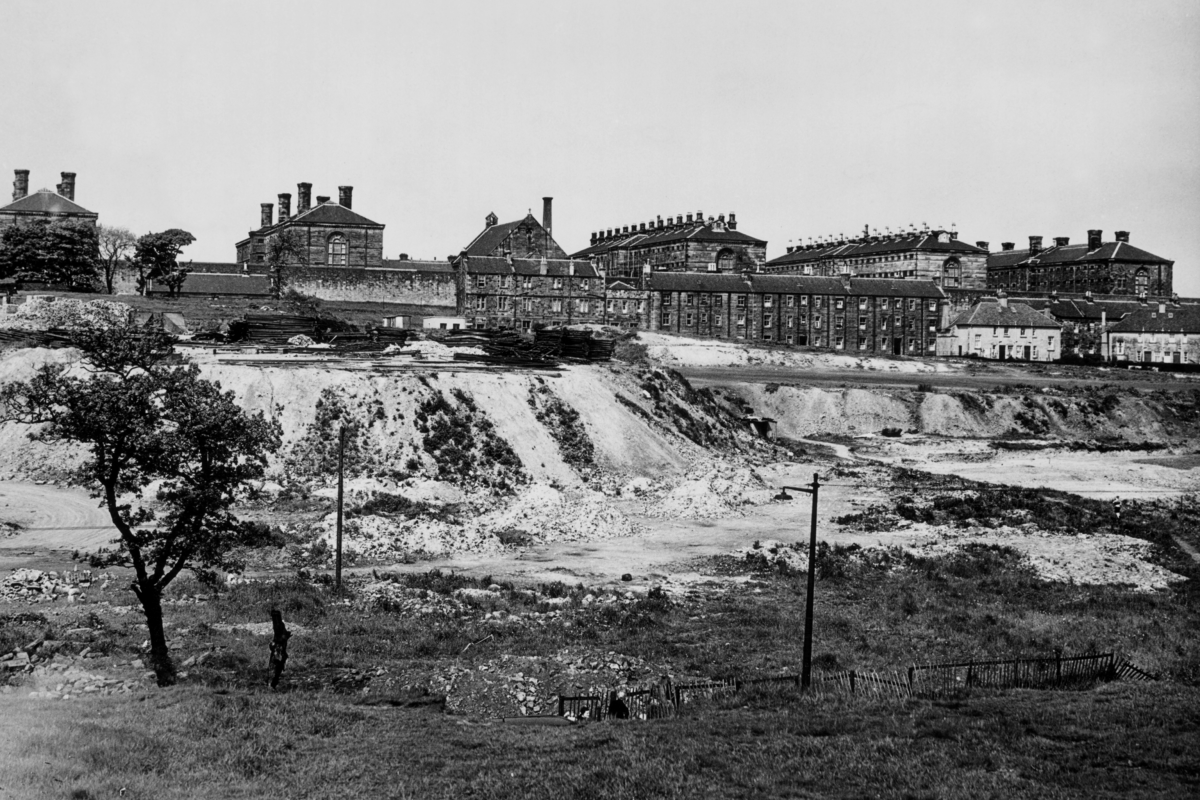
Barlinnie Prison, situated on the north-eastern outskirts of Glasgow (no date).
Image credit: © Newsquest (Herald & Times)
Building Barlinnie
HMP Barlinnie was built to replace eight small prisons across Glasgow city and the west of Scotland. Glasgow's rapid population growth in the 19th century meant these existing custodial facilities were increasingly rundown and overcrowded. Major General Thomas Bernard Collinson, the architect and engineer to the Scottish Prison Department, was called up to produce plans for Barlinnie prison. The original drawings consisted of four accommodation blocks which were four-stories high and could house 200 prisoners.
A site on the north-eastern outskirts of the city in Riddrie was purchased in 1879 and construction started in 1880. The building of the new Barlinnie prison took six years to complete.
Image
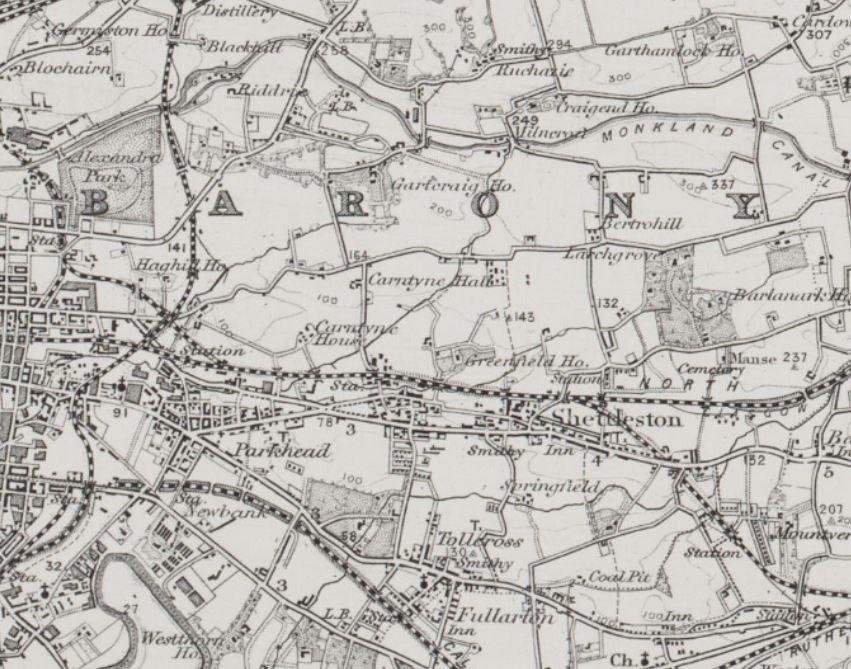
This map of the east of Glasgow city, 1902, depicts a rural landscape, which is now an urban area. Barlinnie Prison can be found located east of Riddrie near the Monkland Canal which is now the route of the M8 motorway.
National Records of Scotland (NRS), RHP5641/1/4
Image
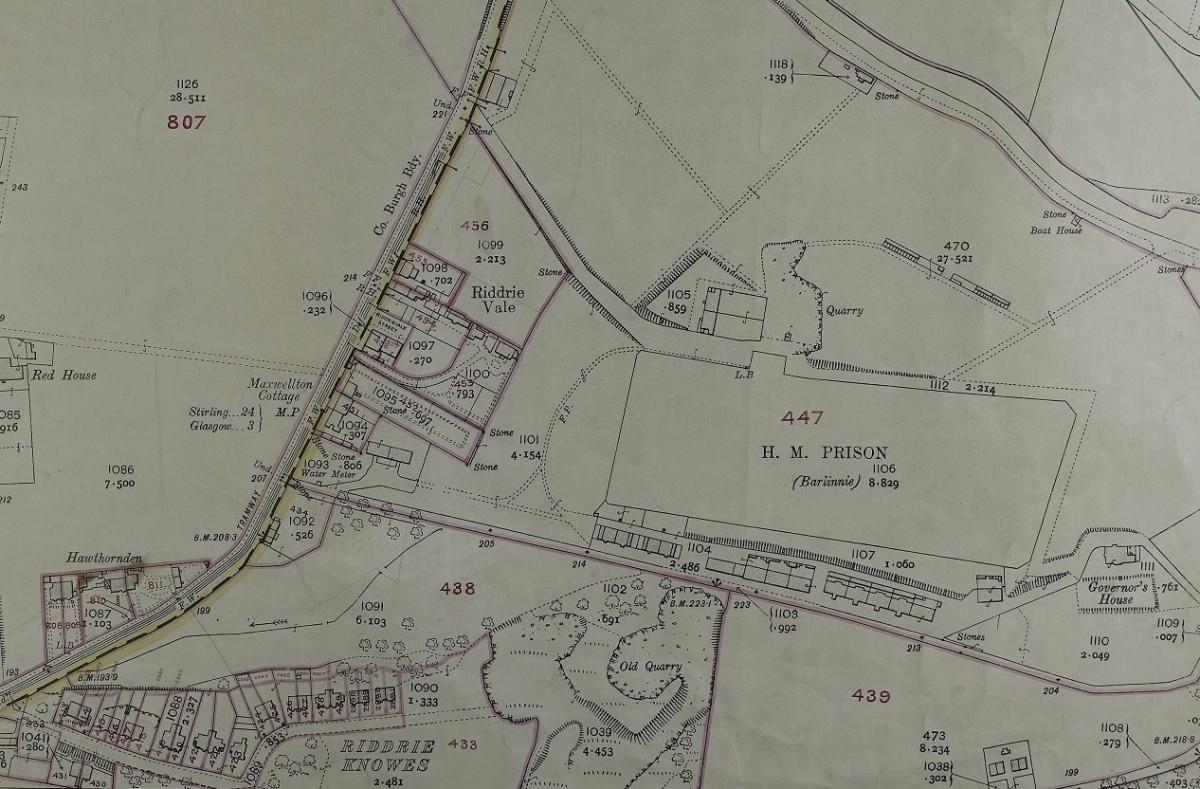
The outline of HM Prison Barlinnie can be found in this Inland Revenue Field Map from the early 20th century.
Crown copyright, NRS, IRS118/81
Barlinnie was created by an order by the Secretary of State, 27 June 1882, under the Prisons (Scotland) Act 1877, as a place of legal detention for criminals of all descriptions. An Order in Council, 26 July 1882, declared the prison to be a General Prison for Scotland.
The construction of Barlinnie eased overcrowding at Glasgow (Duke Street) Prison and allowed the Prison Commissioners to close the inadequate prisons at Campbeltown, Rothesay, Airdrie, Hamilton and Lanark.
Each block of the prison was brought into use upon completion, and the first prisoners arrived at A Hall on 15 August 1882. B, C and D Halls were completed between 1883 and 1892, and a further block ‘E Hall’ was added in 1896 to ease overcrowding. This increased capacity to approximately one thousand prisoners.
To keep costs down, prisoners from A Hall were used as labourers to construct further accommodation blocks and structures within the boundary walls. The prisoners involved in this work were serving short sentences of three to fourteen days and received a different diet from longer serving prisoners. They were given a supplement to their morning meal; ‘a six-ounce roll and half-a-pint of buttermilk before going to their work in the morning’ (Crown copyright, NRS, Prison Commissioners for Scotland, Minute Book, HH35/2, page 360).
Barlinnie alias “BarHell”
Life as an early inmate at HMP Barlinnie was extremely hard. It soon developed a reputation as a tough prison, and across the years prisoners have nicknamed it ‘BarHell’ and the ‘Big hoose’. Initially, prisoners were occupied breaking rocks from the local quarry. A common punishment for unruly behaviour appears to have been ‘handcuffs behind [their back] & canvas jacket at night’ or a number of nights. The prisoner would be assessed as fit for this punishment by the Prison Surgeon, and the warden would administer the cuffs and or jacket (NRS, Barlinnie Governor’s Journals, 1880-1891, HH12/25).
Religious services in the Roman Catholic and Presbyterian faiths were provided from when the prison first opened in August 1882, but a chapel in the prison grounds was not completed until 1894. The prison chaplain notes that access to library books were appreciated by prisoners but they ‘prefer books that treat on secular subjects, rather than those whose works which discuss religious topics’ (Report of Medical Advisors to the Prison Commissioners, 1882-83, App., XXXI, p. 103).
In the 1930s structural additions were made, including staff offices (1933), a gymnasium, and a new library (1939). From 1946 onwards, Barlinnie General Prison served as a place of execution and the prison’s purpose-built hanging shed was used on 10 occasions between 1946 and 1960. Those who went to the gallows included the serial murderer Peter Manuel (1958) and nineteen year old Anthony Miller (1960). The bodies of the executed men were buried in unmarked graves in the prison grounds.
New thinking around punishment and rehabilitation in the 1970s saw the introduction of an experimental therapeutic facility designed to reform the most violent and disruptive inmates. The Barlinnie Special Unit (BSU), was in operation between 1973 to 1994 and sparked worldwide interest. Those committed to the BSU did not wear prison uniforms and had some input on how the unit should be managed. Despite some high-profile success stories, such as the sculptor and writer Jimmy Boyle, the unit was closed due to the loss of confidence from government ministers and prison officials. The prison was progressively modernised between 1997-2004, with flush toilets being added to cells, and finally ending the practice of ‘slopping out’.
The end of an era
After 142 years as Glasgow’s main prison, the story of HMP Barlinnie is close to ending. The prison now holds 500 more prisoners than it was designed for, and is becoming increasingly difficult and expensive to maintain. In 2020, HMP Barlinnie was deemed unfit for purpose and a new purpose-built prison - HMP Glasgow – is scheduled to open in 2027.
The release on Scotland’s People of the admission registers of HMP Barlinnie, and its associated photograph album of prisoners, will give researchers a fascinating insight into the people behind the prison’s imposing walls. In some instances, we can put a face to the names listed, and explore how and why these men ended up in prison, and what happened to them after their release.
Death over breakfast
Prisoner profile: Thomas Johnston
The Aberdeen Journal dated 26 January 1891 states that two men quarrelled ‘over the quality of the meal provided for his breakfast, and both proceeded to the backyard “to fight it out”’. The men involved were John Wood, aged 46, and his stepson Thomas Johnston, aged only 17. Wood was killed.
Johnston and his three brothers lived with their mother and Wood in a cramped two roomed apartment at 138 Drygate, Glasgow. The bedroom accommodated the adults while the children, including Wood’s own son from a previous marriage, Alexander, slept in the kitchen. Wood “was addicted to liquor” and had previous altercations with his eldest stepson, Thomas. Wood had repeatedly taunted his stepsons about their Chinese heritage and their original last name of Jan Sing. Wood and Johnston had previously fought one another, causing Johnston’s mouth to bleed.
Image

Birth certificate of Thomas Johnston or Jan Sing. His father has signed the register using his ‘mark.’
Crown copyright, Statutory Register of Births, 1873, 644 / 5 / 117
Johnston also felt that that his stepfather belittled his youngest brother, James. By looking at witness statements taken before the trial, the boys’ mother stated that the deceased “had always an ill feeling towards my youngest boy James aged 4 and a half years from my first marriage”.
On the morning Wood was killed, Thomas’s brother Samuel, aged 15, gave evidence that a quarrel had occurred over a breakfast Wood had cooked. He heard Wood “calling my mother’s family pigs and he said he was not going to feed them” (Precognition papers, NRS, AD14/91/20). Wood entered the kitchen where the boys were trying to sleep. Samuel’s witness statement describes how Wood entered the kitchen and said he would “fight the whole Mongolian race of them and he challenged Thomas to fight.”
The fight took place outside and witnesses say that Thomas received a heavy beating. The two men were dragged apart by neighbours on the tenement stair. Thomas took out his knife used for cutting tobacco and stabbed his stepfather in the heart. Wood was taken back to their flat and it was not until later that his family realised he had been seriously wounded. Thomas dressed and reported himself to the nearest Police Station to give himself up.
The post-mortem of Wood took place two days after the incident on 27 January 1891. The cause of death is listed as “penetrating wound to the heart, inflicted by a sharp instrument.” (NRS, Court Trial papers, JC26/1891/52)
Initially charged with murder, Thomas Johnston plead guilty to the lesser charge of culpable homicide.
Image

Thomas Johnston was sent to Barlinnie Prison on 4 March 1891. This was his first criminal conviction. Johnston was released exactly a year later. His age on admission is given as 17 and his height 5 foot 3 and a half inches. He was listed as working as a brush maker.
NRS, Barlinnie Prison register, HH21/70/9 p.101
Three years after his release from HMP Barlinnie, Thomas Johnston married Elizabeth Scott and their union is recorded in the 1895 Statutory Registers of Marriage.
A Barlinnie native
Prisoner profile: Peter Davidson alias John Porter
The recent Barlinnie Prison records release includes a rare example of a photograph volume of prisoners for the period 1882-1891. Although images do not exist for all prisoners, this unusual record allows us to follow one individual, through multiple stays, in Barlinnie Prison.
The first time John Porter appears in the photograph album is on his liberation from HMP Barlinnie in March 1883. He had just served 60 days for ‘Being a rogue & vagabond’, under an act designed to criminalise begging and rough sleeping.
Image

Peter Davidson alias John Porter. The photograph was on his liberation from Barlinnie Prison on 23 March 1883.
Crown copyright, NRS, HH21/70/97 p. 10
John Porter from Glasgow looks much younger than his 17 years. The prison admission book notes that he has a tattoo on his left arm of ‘AD JH’ and details his small stature of five foot, 2 inches, and his weight of 118 pounds.
He appears again in December of the same year. Despite the short time between stays, he seems to have matured considerably:
Image

John Porter on the day of his liberation from Barlinnie Prison on 30 December 1883.
Crown copyright, HH21/70/97 p. 40
Porter’s third and final appearance in the Barlinnie Prison photograph volume is in July 1885. Porter is aged 18 and according to the admission register, has grown to the height of five foot 4 inches. His mature appearance is a contrast to the portrait taken a little over a year earlier.
Image
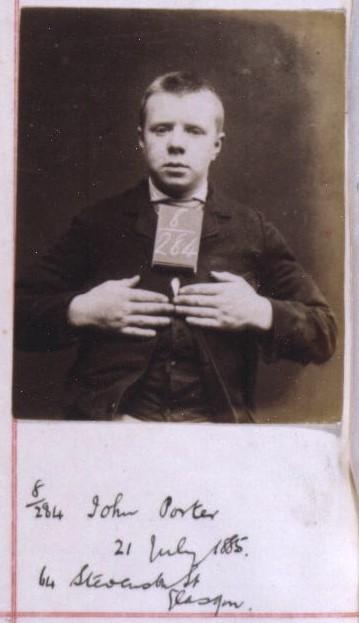
John Porter appearing for the third time in the photograph volume.
Crown copyright, NRS, HH21/70/97 p. 55
On this occasion he was imprisoned on a charge of Contravention of the Police Scotland Act 1871, Section 15. This relates to evidence of vagrancy and the intent to commit felony. The longest prison term for this crime was three months, which Porter received with hard labour. He arrived at the prison on 21 April 1885 and was released on 21 July 1885, as stated on his photograph.
Although he was only photographed three times by the Prison authorities, Porter had become a regular inmate of Barlinnie Prison during his teenage years, primarily for offences of vagrancy. Porter served a total of five short sentences between 1883-1885. The detail below from Barlinnie Prison admission register informs us that he has been in the said prison four previous times, and gives his last prisoner number as ‘7/1890’.
Image

‘Four’ times previously in Barlinnie Prison for John Porter. His age, 18, and height, 5 foot 4 inches, are also recorded. Detail from Barlinnie Prison admission register, 1885.
Crown copyright, NRS, HH21/70/1 p. 162
This would not be his last committed crime. While being tried at Glasgow High Court on 11 September 1888 for multiple charges of theft, he claimed he could not have committed the offence as he was in Barlinnie Prison at the time. His statement recorded in the court minute books, is given below:
Image
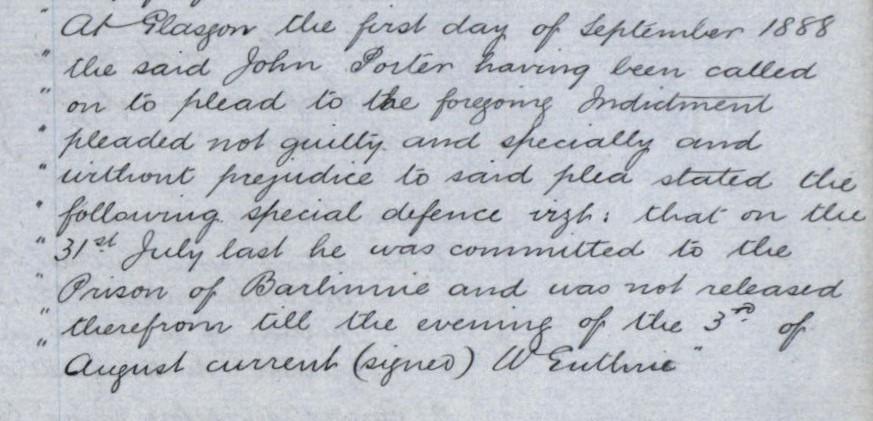
The High Court minute book records the details of Porter’s trial and his own statement to the court on 11 September 1888.
Crown copyright, NRS, JC13/116 p. 40
Despite the alibi provided by Porter, stating that he was released on 'the evening of the 3rd of August' this does not account for the spate of thefts he was charged with. They were believed to have taken place after he was liberated from prison between 1 and 9 August. Porter was found guilty and sentenced to 18 months imprisonment. By searching the admission registers, it appears that Porter was not sent to Barlinnie to serve this sentence. As he was a repeat offender, he may have been sent to, the-then newly opened, HMP Peterhead in Aberdeenshire.
A dangerous affair
Prisoner profile: Hugh Abernethy
Hugh Abernethy, aged 26, was admitted into Barlinnie Prison on 28 June 1887, having plead guilty on a charge of assault. Unfortunately, Abernethy’s likeness was not captured by the prison’s photographer, but his case was an infamous one and it was followed closely by the press.
The case files present a timeline of events:
• On 28 February 1887, Abernethy visited the Kelvinside area of Glasgow to see his sweetheart, Euphemia Hamilton. Abernethy fired a revolver at Hamilton before fleeing the scene. Hamilton was not injured.
• On 12 May 1887 Abernethy appeared at Hamilton’s place of work, Findlay & Reid bootmakers on Charlotte Lane. Upon seeing Hamilton standing behind the shop counter, he took aim and fired, but missed her a second time. At this point, Abernethy turned the gun on himself, injuring his neck and head in the process.
When the case came to trial, Abernethy’s counsel, Mr McClure, asked for as ‘lenient a sentence as possible, because no bodily harm was done to the person attacked’ (Glasgow Weekly Herald, 2 July 1887). McClure went on to state that Abernethy did not ‘belong to the criminal class’ and had been courting Hamilton but discovered that she had been ‘going with other men.’ His ‘state of desperation’ was protracted when he found out that Hamilton was married and had an illegitimate child. Abernethy went to her house to seek an explanation, but when Hamilton refused to see him, he committed the above offences.
Hearing that the accused had tried to kill himself after the second attempt, the court decided Abernethy was ‘not in his right mind’. However the judge declared that he should not have sought revenge on a woman who had wronged him. Given that he attempted to shoot Hamilton on two separate occasions, Abernethy was sentenced to spend only 12 months in Barlinnie.
Image

Hugh Abernethy’s family enumerated in the 1911 census at 37 Stanhope Street, Glasgow. The marriage of 16 years has created 5 children, but only 4 are alive.
Crown copyright, NRS, 1911 census, 644/8 18/13
After serving his sentence in Barlinnie Prison, Abernethy appears to have reset his life. He can be found in the 1911 census aged 50, married to Jessie Taylor (married 1894), with four children.
In this article we have explored the diverse history of HMP Barlinnie, reflecting on its inmates over the centuries. The admission registers of Barlinnie (Glasgow) and Perth General Prisons, Largs Jail and Edinburgh's Bridewell and Calton Prisons are accessible on Scotland's People. The Prison registers record guide will give you tips on searching the records and what type of information these register contain.
Further reading
For more information on searching the Prison Registers on Scotland's People, and what they contain, see our Prison register record guide.
You may find the handwriting in the prison records difficult to read. Look at the guides on reading older handwriting, unfamiliar words and phrases, and search the glossary for assistance with abbreviations, legal terminology, occupations and other unfamiliar words.
 Latest News Articles
Latest News Articles Do you have an RSS newsreader? You may prefer to use this newsletter's RSS feed at:
Do you have an RSS newsreader? You may prefer to use this newsletter's RSS feed at: